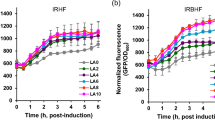Abstract
The study on membrane proteins is an important challenge mainly because of their very poor solubility in various solvents. The traditional recombinant expression strategy and the native chemical ligation method both have difficulty in generating sufficient amounts of desired proteins with high efficiency. Previous studies have shown that multiply fluorinated alcohols exhibit good ability to dissolve difficult peptide sequences, especially hexafluoro-2-propanol (HFIP). In the present study we systematically studied the capability of solvents containing different percentage of HFIP in dissolving transmembrane peptides. Through both HPLC and UV analyses we concluded that 60% HFIP/8 M urea constituted a good solvent system. In this solvent system we also optimized conditions to perform native chemical ligation (NCL). Under the optimized conditions we successfully achieved NCL’s for both dipeptide formation and the synthesis of a model protein (Trifolitoxin). These results suggested that HFIP was a potential cosolvent that could be used in the ligation of poorly soluble peptides for the generation of membrane proteins.
Similar content being viewed by others
References
Wallin E, Heijne GV. Genome-wide analysis of integral membrane proteins from eubacterial, archaean, and eukaryotic organisms. Protein Sci, 1998, 7: 1029–1038
Olschewski D, Becker CFW. Chemical synthesis and semisynthesis of membrane proteins. Mol Biosystems, 2008, 4: 733–740
Kochendoerfer GG, Kent SBH. Chemical protein synthesis. Curr Opin Chem Biol, 1999, 3: 665–671
Dawson PE, Muir TW, Clarklewis I, Kent SBH. Synthesis of proteins by native chemical ligation. Science, 1994, 266: 776–779
Muir TW, Sondhi D, Cole PA. Expressed protein ligation: A general method for protein engineering. Proc Nat Acad Sci USA, 1998, 95: 6705–6710
Arkin IT, Adams PD, Brunger AT, Smith SO, Engelman DM. Structural perspectives of phospholamban, a helical transmembrane pentamer. Annu Rev Biophys Biomol Struct, 1997, 26: 157–179
Kochendoerfer GG, Salom D, Lear JD, Wilk-Orescan R, Kent SBH, DeGrado WF. Total chemical synthesis of the integral membrane protein influenza A virus M2: Role of its C-terminal domain in tetramer assembly. Biochemistry, 1999, 38: 11905–11913
Hunter CL, Kochendoerfer GG. Native chemical ligation of hydrophobic peptides in lipid bilayer systems. Bioconjugate Chem, 2004, 15: 948–948
Grogan MJ, Kaizuka Y, Conrad RM, Groves JT, Bertozzi CR. Synthesis of lipidated green fluorescent protein and its incorporation in supported lipid bilayers. J Am Chem Soc, 2005,127: 14383–14387
Bianchi E, Ingenito R, Simon RJ, Pessi A. Engineering and chemical synthesis of a transmembrane protein: The HCV protease cofactor protein NS4A. J Am Chem Soc, 1999, 121: 7698–7699
Johnson ECB, Kent SBH. Towards the total chemical synthesis of integral membrane proteins: a general method for the synthesis of hydrophobic peptide-(alpha)thioester building blocks. Tetrahedron Lett, 2007, 48: 1795–1799
Becker CFW, Strop P, Bass RB, Hansen KC, Locher KP, Ren G, Yeager M, Rees DC, Kochendoerfer GG. Conversion of a mechanosensitive channel protein from a membrane-embedded to a water-soluble form by covalent modification with amphiphiles. J Mol Biol, 2004, 343: 747–758
Marsac Y, Cramer J, Olschewski D, Alexandrov K, Becker CFW. Site-specific attachment of polyethylene glycol-like oligomers to proteins and peptides. Bioconjugate Chem, 2006, 17: 1492–1498
Abe R, Caaveiro JMM, Kudou M, Tsumoto K. Solubilization of membrane proteins with novel N-acylamino acid detergents. Mol Biosystems, 2010, 6: 677–679
Schrier EE, Ingwall RT, Scheraga HA. Effect of aqueous alcohol solutions on thermal transition of ribonuclease. J Phys Chem, 1965, 69: 298–&
Buck M, Schwalbe H, Dobson CM. Main-chain dynamics of a partially folded protein: N-15 NMR relaxation measurements of hen egg white lysozyme denatured in trifluoroethanol. J Mol Biol, 1996, 257: 669–683
Hong DP, Hoshino M, Kuboi R, Goto Y. Clustering of fluorine-substituted alcohols as a factor responsible for their marked effects on proteins and peptides. J Am Chem Soc, 1999, 121: 8427–8433
Kochendoerfer GG, Jones DH, Lee S, Oblatt-Montal M, Opella SJ, Montal M. Functional characterization and NMR spectroscopy on full-length Vpu from HIV-1 prepared by total chemical synthesis. J Am Chem Soc, 2004, 126: 2439–2446
Vorherr T, Wrzosek A, Chiesi M, Carafoli E. Total synthesis and functional properties of the membrane-intrinsic protein phospholamban. Protein Sci, 1993, 2: 339–347
Valiyaveetil FI, MacKinnon R, Muir TW. Semisynthesis and folding of the potassium channel KcsA. J Am Chem Soc, 2002, 124: 9113–9120
Hirota N, Mizuno K, Goto Y. Cooperative alpha-helix formation of beta-lactoglobulin and melittin induced by hexafluoroisopropanol. Protein Sci, 1997, 6: 416–421
Fang GM, Cui HK, Zheng JS, Liu L. Chemoselective ligation of peptide phenyl esters with N-terminal cysteines. ChemBioChem, 2010, 11: 1061–1065
Zheng JS, Cui HK, Fang GM, Xi WX, Liu L. Chemical protein synthesis by kinetically controlled ligation of peptide O-esters. ChemBioChem, 2010, 11: 511–515
Schnolzer M, Alewood P, Jones A, Alewood D, Kent SBH. In situ neutralization in boc-chemistry solid phase peptide synthesis — Rapid, high yield assembly of difficult sequences. Inter J Peptide Res Therapeutics, 2007, 13: 31–44
Eduardo AR, Scupham AJ, Triplett EW. Trifolitoxin production in rhizobium etli strain ce3 increases competitiveness for rhizosphere colonization and root nodulation of Phaseolus vulgaris in soil. MPMI, 1997, 10, 228–233
Author information
Authors and Affiliations
Corresponding author
Rights and permissions
About this article
Cite this article
Shen, F., Tang, S. & Liu, L. Hexafluoro-2-propanol as a potent cosolvent for chemical ligation of membrane proteins. Sci. China Chem. 54, 110–116 (2011). https://doi.org/10.1007/s11426-010-4188-4
Received:
Accepted:
Published:
Issue Date:
DOI: https://doi.org/10.1007/s11426-010-4188-4




